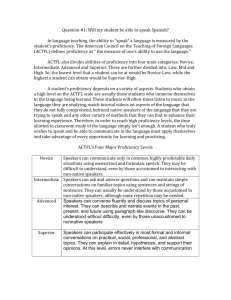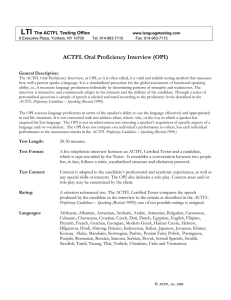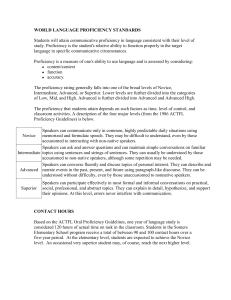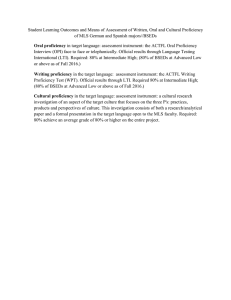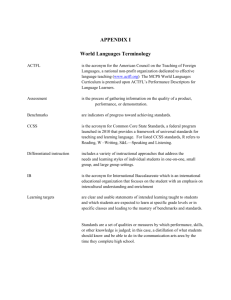Oral PrOficiency interview Familiarization manual www.actfl.org
advertisement
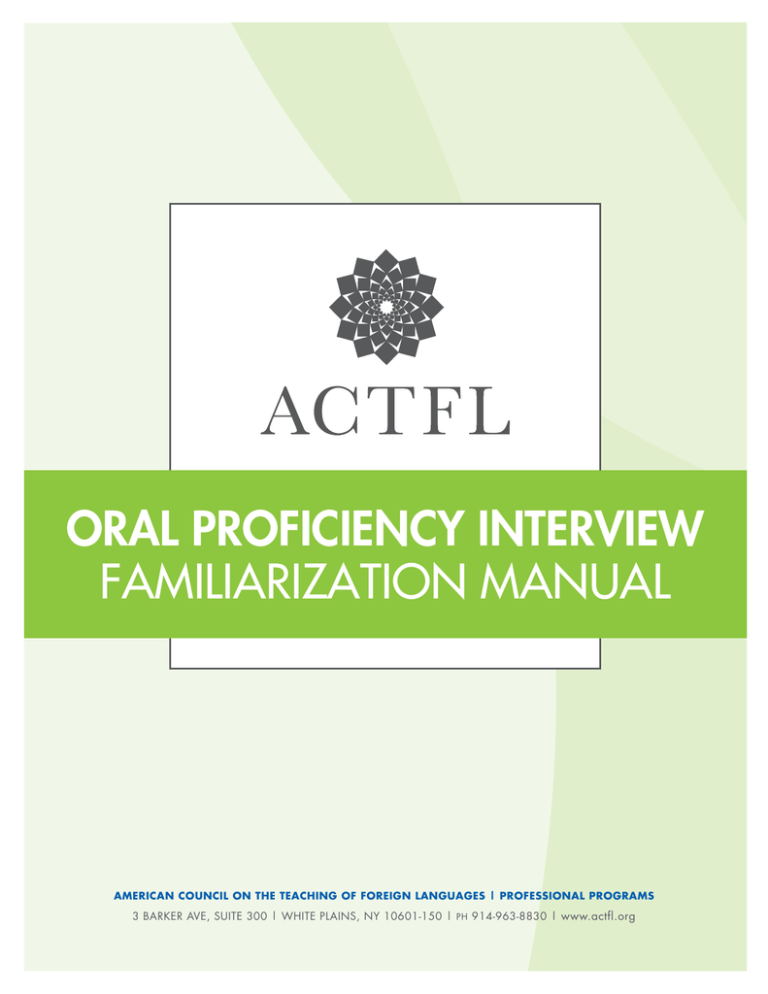
Oral Proficiency Interview Familiarization Manual American Council on the Teaching of Foreign Languages | Professional Programs 3 Barker Ave, Suite 300 | White Plains, NY 10601-150 | ph 914-963-8830 | www.actfl.org Oral Proficiency Interview Familiarization Manual What Is ACTFL? The American Council on the Teaching of Foreign Languages (ACTFL) is a national membership organization of foreign language professionals dedicated to promoting and fostering the study of languages and cultures as an integral component of American education and society. ACTFL strives to provide effective leadership for the improvement of teaching and learning of languages at all levels of instruction and in all languages. Its membership of more than 12,000 language professionals includes elementary, secondary, and post-secondary teachers; administrators; specialists; supervisors; researchers, and others concerned with language education. ACTFL represents all languages and all levels of language instruction. What are the ACTFL Proficiency Guidelines? The ACTFL Proficiency Guidelines 2012 are descriptions of what individuals can do with language in terms of speaking, writing, listening, and reading in real-world situations in a spontaneous and non-rehearsed context. For each skill, these guidelines identify five major levels of proficiency: Distinguished, Superior, Advanced, Intermediate, and Novice. The major levels Advanced, Intermediate, and Novice are subdivided into High, Mid, and Low sublevels. These Guidelines present the levels of proficiency as ranges and describe what an individual can do with language at each level, and cannot do at the next higher level, regardless of where, when, or how the language was acquired. Together these levels form a hierarchy in which each level subsumes all lower levels. The Guidelines are not based on any particular theory, pedagogical method, or educational curriculum. They neither describe how an individual learns a language nor prescribe how an individual should learn a language, and they should not be used for such purposes. They are an instrument for the evaluation of functional language ability. The ACTFL Proficiency Guidelines 2012– Speaking describe spoken language ability from that of a highly articulate, well-educated speaker (Distinguished) to that of an individual with little or no functional ability in spoken language (Novice). These Guidelines are the basis for rating ACTFL Oral Proficiency Interviews (OPIs). 3 | ORAL Proficiency INTERVIEW FAMILIARIZATION MANUAL 2012 © ACTFL, Inc., 2012 What is the Oral Proficiency Interview? The ACTFL Oral Proficiency Interview (OPI) is a valid and reliable testing method that measures how well a person speaks a language. It uses a standardized procedure for the global assessment of functional speaking ability, i.e., it measures language production holistically by determining patterns of strengths and weaknesses. The ACTFL OPI is interactive and adaptive, adjusting to the interests, experiences, and the linguistic abilities of the test takers. Through a series of personalized questions, a sample of speech is elicited and rated according to the proficiency levels described in the ACTFL Proficiency Guidelines 2012– Speaking. The ACTFL OPI assesses the Interpersonal mode of communication (two-way communication) as described in the Standards for Foreign Language Learning. The OPI assesses language proficiency in terms of a speaker’s ability to use the language effectively and appropriately in real-life situations. It does not address when, where, why, or the way in which a speaker has acquired his/her language. The OPI is not an achievement test assessing a speaker’s acquisition of specific aspects of course and curriculum content, nor is it tied to any specific method of instruction. The OPI does not compare one individual’s performance to others, but each individual performance to the assessment criteria. What is the ACTFL Rating Scale? While the ACTFL Proficiency Guidelines 2012 – Speaking describe five major levels of spoken language proficiency (Distinguished, Superior, Advanced, Intermediate, Novice), the ACTFL Rating Scale (derived from the Guidelines) encompasses four major levels. These are: Superior Advanced Superior Can support opinion, hypothesize, discuss topic concretely and abstractly, and handle a linguistically unfamiliar situation Advanced Can narrate and describe in all major time frames and handle a situation with a complication Intermediate Can create with language, ask and answer simple questions on familiar topics, and handle a simple situation or transaction Novice Can communicate minimally with formulaic and rote utterance, lists, and phrases Intermediate Novice The four major levels are delineated according to a hierarchy of global tasks. This hierarchy is summarized in a rating scale spanning a wide range of performance profiles, from those of speakers who are able to participate effectively in most formal and informal conversations on practical, social, and professional topics and issues to those of beginning learners. The scale describes a full range of proficiency from Superior to Novice. Major borders divide the major levels of the scale (Superior, Advanced, Intermediate, Novice). As shown in the inverted pyramid (see Figure 1), each level represents a different profile of functional language ability. Figure 1 4 | ORAL Proficiency INTERVIEW FAMILIARIZATION MANUAL 2012 © ACTFL, Inc., 2012 The major levels are further divided by minor borders into high, mid and low sub-levels. These sub-levels differ from each other in terms of the quantity as well as the quality of language produced and in some cases by the tasks performed. The “High” sublevel Speakers at “High” sublevel communicate with ease and confidence when performing the functions of their respective level. They are capable of functioning much of the time at the next higher major level and may spontaneously raise the exchange to that level, but they are unable to sustain language at that next higher level without intermittent lapses or evidences of difficulty. The “Mid” sublevel Speakers at the “Mid” sublevel represent a number of speech profiles, based on their particular mix of quantity (sheer volume of speech produced) and/or quality (efficiency and effectiveness with which meaning is communicated) at level, and/ or the degree to which they control language features from the next higher major level base level. The “Low” sublevel Speakers at the “Low” sublevel summon up all their linguistic energy to sustain the requirements of the level. The “Low” functions primarily within the level with minimal quantity and quality of language and little or no demonstrated ability to perform the tasks of the next higher level. As shown in the inverted pyramid in Figure 2, each level represents a range of functional language ability. Superior Advanced High Advanced Mid Advanced Low Intermediate High Intermediate Mid Intermediate Low Novice High Novice Mid Novice Low Figure 2 5 | ORAL Proficiency INTERVIEW FAMILIARIZATION MANUAL 2012 © ACTFL, Inc., 2012 What Assessment Criteria are Used? The Oral Proficiency Interview addresses a number of criteria simultaneously. The OPI is an integrative assessment that evaluates spoken language ability from a global perspective rather than based on the presence or absence of any given linguistic feature. Linguistic components are viewed in the context of their contribution to overall speaking performance. In evaluating a speech sample, the following criteria are considered: • the functions or global tasks the speaker performs, • the social contexts and specific content areas in which the speaker is able to perform them, • the accuracy (i.e., degree to which the message is understood), and • the type of oral text or discourse the speaker is capable of producing. A summary of assessment criteria according to level of proficiency is presented in the following table: Proficiency Level* Global Tasks and Functions Context / Content Superior Most formal and informal settings. Discuss topics extensively, support opinions and hypothesize. Wide range of general interest Deal with a linguistically topics and some special fields of unfamiliar situation. interest and expertise. Advanced Narrate and describe in major time frames and deal effectively with an unanticipated complication. Intermediate Novice Create with language, initiate, maintain, and bring to a close simple conversations by asking and responding to simple questions. Communicate minimally with formulaic and rote utterances, lists, and phrases Some informal settings and a limited number of transactional situations. Predictable, familiar topics related to daily activities. Some informal settings and a limited number of transactional situations. Predictable, familiar topics related to daily activities. Most common informal settings. Most common aspects of daily life. Accuracy Text Type No pattern of errors in basic structures. Errors virtually never interfere with communication or distract the native speaker from the message. Extended discourse Understood, with some repetition, by speakers accustomed to dealing with non-native speakers. Paragraphs Understood, with some repetition, by speakers accustomed to dealing with non-native speakers. Discrete sentences May be difficult to understand, even for speakers accustomed to dealing with non-natve speakers. Individual words and phrases 6 | ORAL Proficiency INTERVIEW FAMILIARIZATION MANUAL 2012 © ACTFL, Inc., 2012 What is the Structure of the ACTFL OPI? The primary goal of the OPI is to produce a ratable sample of speech. To be ratable, a speech sample must clearly demonstrate the highest sustained level of performance of the speaker (known as the “floor”) and the level at which the speaker can no longer sustain the performance (known as the “ceiling”), over a variety of topics. To this end, the tester follows a specific protocol, with four mandatory phases, in order to elicit a ratable sample. The four mandatory phases of the OPI are: Warm Up, Level Checks, Probes, Wind Down The Phases of the OPI The Warm Up This first phase of the OPI serves as the introduction to the interview. It consists of greetings, informal exchanges of pleasantries, and conversation openers pitched at a level which appears comfortable for the speaker. Every OPI begins with the assumption that a conversation will take place (Intermediate Level). Iterative Process The Level Checks When the speaker has settled into the interview and appears to be reasonably comfortable using the target language, the interviewer moves to the next phase of the OPI, the level checks. The interviewer engages the speaker in conversation on several topics of interest so that the tasks characterizing any given level can be performed. Level checks are questions that elicit the performance floor, the linguistic tasks and contexts of a particular level which can be handled successfully. → The Probes Once the interviewer has begun to establish that the speaker can handle the tasks and topics of a particular level, the interview proceeds to the next phase, the probes. The Wind Down The final phase returns the speaker to a comfortable level of language exchange and ends the OPI on a positive note. The purpose of the probes is to discover the ceiling or limits of the speaker’s proficiency, i.e. the patterns of weakness. This is done by raising the level of the interview to the next higher major level in an attempt to discover the level at which the speaker can no longer sustain functional performance. The Role Play A transactional or social situation can serve as either an additional level check or probe as needed in a particular interview. What Strategies are used to elicit a Ratable Sample? When eliciting a ratable sample, successful testers ask open-ended questions in order to encourage the speaker to show his or her language ability at its best. Testers listen to and process a speaker’s responses before formulating subsequent questions. Testers ask purposeful questions; every question targets a specific level and function of that level. Testers explore a variety of topics within and across major levels of the ACTFL scale. How is the Sample Rated? Once a ratable sample of speech has been elicited, that sample is compared to the assessment criteria of the rating scale. A rating at any major level is determined by identifying the speaker’s floor and ceiling. The floor represents the speaker’s highest sustained performance across ALL of the criteria of the level all of the time in the Level Checks for that particular level; the ceiling is evidenced 7 | ORAL Proficiency INTERVIEW FAMILIARIZATION MANUAL 2012 © ACTFL, Inc., 2012 by linguistic breakdown when the speaker is attempting to address the tasks presented in the Probes. An appropriate sublevel can then be determined, and one of ten possible ratings is assigned by comparing the sample to the description in the ACTFL Proficiency Guidelines 2012 –Speaking and identifying the rating that best matches the sample. Who are the Testers and how are they trained? ACTFL certified testers are highly specialized language professionals who have completed a rigorous training process that concludes with a tester’s demonstrated ability to elicit consistently ratable speech samples and consistently rate samples with a high degree of reliability. Following attendance at an ACTFL OPI or MOPI Assessment Workshop, a participant may apply for one of two levels of tester certification. ACTFL testers with Full Certification are authorized to conduct and rate OPIs across all proficiency levels. Testers with Limited Certification are authorized to conduct and rate OPIs at the Novice and Intermediate levels. Tester trainees must also take an official OPI to demonstrate their own language proficiency. Testers wishing to pursue Full Certification must have a Superior rating and those wishing to apply for Limited Certification must demonstrate an Advanced Mid rating. The certification process involves completion of an online listen-and-rate activity followed by the preparation and submission of recorded OPIs. Recorded OPIs are reviewed by a trainer who then provides detailed feedback on structure, elicitation, and rating skills. ACTFL Tester certification is awarded for a four year period during which testers are required to complete a one-time renorming and refresher activity. Testers must also recertify once every four years. What is an Official ACTFL OPI Rating? Official ACTFL OPI ratings are assigned to those OPIs conducted by ACTFL certified OPI testers under the supervision of Language Testing International (LTI), the ACTFL Testing Office. Each Official OPI is blindly double rated by a second certified tester. The two ratings must agree exactly in both the major level and sublevel. The final rating is assigned and an ACTFL OPI Certificate is issued. The ACTFL Oral Proficiency Interview (OPI)® is a trademarked property of the American Council on the Teaching of Foreign Languages (ACTFL). The ACTFL OPI elicitation and rating protocols are proprietary to ACTFL. The ACTFL OPI Familiarization manuals and materials are proprietary to ACTFL; use, duplication or distribution of these materials is permitted for ACTFL authorized purposes only. The ACTFL OPI is rated according to the ACTFL Guidelines 2012© ACTFL, Inc. 2012. How is the ACTFL OPI Currently Being Used? The ACTFL OPI is currently being used for a variety of purposes in the academic, commercial, and government contexts. Because an ACTFL OPI rating provides a common metric for describing a speaker’s functional ability in a language, it serves as a way of providing articulation among language programs. OPI ratings are commonly used for purposes of admission into programs, placement within a language sequence, and determination of the fulfillment of exit or graduation requirements. Teacher Certification Boards in some states require evidence of spoken language competency as demonstrated through an Official ACTFL OPI. In some cases an ACTFL Official OPI rating can be used to waive certain language requirements for teacher certification. The OPI and OPI ratings are widely used in the business world and in government for purposes of hiring and promotion in multilingual positions. 8 | ORAL Proficiency INTERVIEW FAMILIARIZATION MANUAL 2012 © ACTFL, Inc., 2012 ACTFL Proficiency Guidelines 2012 SPEAKING Preface The ACTFL Proficiency Guidelines 2012 – Speaking describe five major levels of proficiency: Distinguished, Superior, Advanced, Intermediate, and Novice. The description of each major level is representative of a specific range of abilities. Together these levels form a hierarchy in which each level subsumes all lower levels. The major levels Advanced, Intermediate, and Novice are divided into High, Mid, and Low sublevels. The Guidelines describe the tasks that speakers can handle at each level, as well as the content, context, accuracy, and discourse types associated with tasks at each level. They also present the limits that speakers encounter when attempting to function at the next higher major level. These Guidelines can be used to evaluate speech that is either Interpersonal (interactive, two-way communication) or Presentational (one-way, non-interactive). The written descriptions of speaking proficiency are accompanied online by speech samples illustrating the features of each major level. The ACTFL Proficiency Guidelines 2012 – Speaking may be used for non-profit, educational purposes only, provided that they are reproduced in their entirety, with no alterations, and with credit to ACTFL. DISTINGUISHED Speakers at the Distinguished level are able to use language skillfully, and with accuracy, efficiency, and effectiveness. They are educated and articulate users of the language. They can reflect on a wide range of global issues and highly abstract concepts in a culturally appropriate manner. Distinguished-level speakers can use persuasive and hypothetical discourse for representational purposes, allowing them to advocate a point of view that is not necessarily their own. They can tailor language to a variety of audiences by adapting their speech and register in ways that are culturally authentic. Speakers at the Distinguished level produce highly sophisticated and tightly organized extended discourse. At the same time, they can speak succinctly, often using cultural and historical references to allow them to say less and mean more. At this level, oral discourse typically resembles written discourse. A non-native accent, a lack of a native-like economy of expression, a limited control of deeply embedded cultural references, and/or an occasional isolated language error may still be present at this level. 9 | ORAL Proficiency INTERVIEW FAMILIARIZATION MANUAL 2012 © ACTFL, Inc., 2012 SUPERIOR Speakers at the Superior level are able to communicate with accuracy and fluency in order to participate fully and effectively in conversations on a variety of topics in formal and informal settings from both concrete and abstract perspectives. They discuss their interests and special fields of competence, explain complex matters in detail, and provide lengthy and coherent narrations, all with ease, fluency, and accuracy. They present their opinions on a number of issues of interest to them, such as social and political issues, and provide structured arguments to support these opinions. They are able to construct and develop hypotheses to explore alternative possibilities. When appropriate, these speakers use extended discourse without unnaturally lengthy hesitation to make their point, even when engaged in abstract elaborations. Such discourse, while coherent, may still be influenced by language patterns other than those of the target language. Superior-level speakers employ a variety of interactive and discourse strategies, such as turn-taking and separating main ideas from supporting information through the use of syntactic, lexical, and phonetic devices. Speakers at the Superior level demonstrate no pattern of error in the use of basic structures, although they may make sporadic errors, particularly in low-frequency structures and in complex high-frequency structures. Such errors, if they do occur, do not distract the native interlocutor or interfere with commu­nication. ADVANCED Speakers at the Advanced level engage in conversation in a clearly participatory manner in order to communicate information on autobiographical topics, as well as topics of community, national, or international interest. The topics are handled concretely by means of narration and description in the major times frames of past, present, and future. These speakers can also deal with a social situation with an unexpected complication. The language of Advanced-level speakers is abundant, the oral paragraph being the measure of Advanced-level length and discourse. Advanced-level speakers have sufficient control of basic structures and generic vocabulary to be understood by native speakers of the language, including those unaccustomed to non-native speech. Advanced High Speakers at the Advanced High sublevel perform all Advanced-level tasks with linguistic ease, confidence, and competence. They are consistently able to explain in detail and narrate fully and accurately in all time frames. In addition, Advanced High speakers handle the tasks pertaining to the Superior level but cannot sustain performance at that level across a variety of topics. They may provide a structured argument to support their opinions, and they may construct hypotheses, but patterns of error appear. They can discuss some topics abstractly, especially those relating to their particular interests and special fields of expertise, but in general, they are more comfortable discussing a variety of topics concretely. Advanced High speakers may demonstrate a well-developed ability to compensate for an imperfect grasp of some forms or for limitations in vocabulary by the confident use of communicative strategies, such as paraphrasing, circumlocution, and illustration. They use precise vocabulary and intonation to express meaning and often show great fluency and ease of speech. However, when called on to perform the complex tasks associated with the Superior level over a variety of topics, their language will at times break down or prove inadequate, or they may avoid the task altogether, for example, by resorting to simplification through the use of description or narration in place of argument or hypothesis. 10 | ORAL Proficiency INTERVIEW FAMILIARIZATION MANUAL 2012 © ACTFL, Inc., 2012 Advanced Mid Speakers at the Advanced Mid sublevel are able to handle with ease and confidence a large number of communicative tasks. They participate actively in most informal and some formal exchanges on a variety of concrete topics relating to work, school, home, and leisure activities, as well as topics relating to events of current, public, and personal interest or individual relevance. Advanced Mid speakers demonstrate the ability to narrate and describe in the major time frames of past, present, and future by providing a full account, with good control of aspect. Narration and description tend to be combined and interwoven to relate relevant and supporting facts in connected, paragraph-length discourse. Advanced Mid speakers can handle successfully and with relative ease the linguistic challenges presented by a complication or unexpected turn of events that occurs within the context of a routine situation or communicative task with which they are otherwise familiar. Communicative strategies such as circumlocution or rephrasing are often employed for this purpose. The speech of Advanced Mid speakers performing Advanced-level tasks is marked by substantial flow. Their vocabulary is fairly extensive although primarily generic in nature, except in the case of a particular area of specialization or interest. Their discourse may still reflect the oral paragraph structure of their own language rather than that of the target language. Advanced Mid speakers contribute to conversations on a variety of familiar topics, dealt with concretely, with much accuracy, clarity and precision, and they convey their intended message without misrepresentation or confusion. They are readily understood by native speakers unaccustomed to dealing with non-natives. When called on to perform functions or handle topics associated with the Superior level, the quality and/or quantity of their speech will generally decline. Advanced Low Speakers at the Advanced Low sublevel are able to handle a variety of communicative tasks. They are able to participate in most informal and some formal conversations on topics related to school, home, and leisure activities. They can also speak about some topics related to employment, current events, and matters of public and community interest. Advanced Low speakers demonstrate the ability to narrate and describe in the major time frames of past, present, and future in paragraph-length discourse with some control of aspect. In these narrations and descriptions, Advanced Low speakers combine and link sentences into connected discourse of paragraph length, although these narrations and descriptions tend to be handled separately rather than interwoven. They can handle appropriately the essential linguistic challenges presented by a complication or an unexpected turn of events. Responses produced by Advanced Low speakers are typically not longer than a single paragraph. The speaker’s dominant language may be evident in the use of false cognates, literal translations, or the oral paragraph structure of that language. At times their discourse may be minimal for the level, marked by an irregular flow, and containing noticeable self-correction. More generally, the performance of Advanced Low speakers tends to be uneven. Advanced Low speech is typically marked by a certain grammatical roughness (e.g., inconsistent control of verb endings), but the overall performance of the Advanced-level tasks is sustained, albeit minimally. The vocabulary of Advanced Low speakers often lacks specificity. Nevertheless, Advanced Low speakers are able to use communicative strategies such as rephrasing and circumlocution. Advanced Low speakers contribute to the conversation with sufficient accuracy, clarity, and precision to convey their intended message without misrepresentation or confusion. Their speech can be understood by native speakers unaccustomed to dealing with non-natives, even though this may require some repetition or restatement. When attempting to perform functions or handle topics associated with the Superior level, the linguistic quality and quantity of their speech will deteriorate significantly. 11 | ORAL Proficiency INTERVIEW FAMILIARIZATION MANUAL 2012 © ACTFL, Inc., 2012 INTERMEDIATE Speakers at the Intermediate level are distinguished primarily by their ability to create with the language when talking about familiar topics related to their daily life. They are able to recombine learned material in order to express personal meaning. Intermediatelevel speakers can ask simple questions and can handle a straightforward survival situation. They produce sentence-level language, ranging from discrete sentences to strings of sentences, typically in present time. Intermediate-level speakers are understood by interlocutors who are accustomed to dealing with non-native learners of the language. Intermediate High Intermediate High speakers are able to converse with ease and confidence when dealing with the routine tasks and social situations of the Intermediate level. They are able to handle successfully uncomplicated tasks and social situations requiring an exchange of basic information related to their work, school, recreation, particular interests, and areas of competence. Intermediate High speakers can handle a substantial number of tasks associated with the Advanced level, but they are unable to sustain performance of all of these tasks all of the time. Intermediate High speakers can narrate and describe in all major time frames using connected discourse of paragraph length, but not all the time. Typically, when Intermediate High speakers attempt to perform Advanced-level tasks, their speech exhibits one or more features of breakdown, such as the failure to carry out fully the narration or description in the appropriate major time frame, an inability to maintain paragraph-length discourse, or a reduction in breadth and appropriateness of vocabulary. Intermediate High speakers can generally be understood by native speakers unaccustomed to dealing with non-natives, although interference from another language may be evident (e.g., use of code-switching, false cognates, literal translations), and a pattern of gaps in communication may occur. Intermediate Mid Speakers at the Intermediate Mid sublevel are able to handle successfully a variety of uncomplicated communicative tasks in straightforward social situations. Conversation is generally limited to those predictable and concrete exchanges necessary for survival in the target culture. These include personal information related to self, family, home, daily activi­ties, interests and personal preferences, as well as physical and social needs, such as food, shopping, travel, and lodging. Intermedi­ate Mid speakers tend to function reactively, for example, b­ y responding to direct ques­tions or requests for information. However, they are capable of asking a variety of questions when necessary to obtain simple information to satisfy basic needs, such as directions, prices, and services. When called on to perform functions or handle topics at the Advanced level, they provide some information but have difficulty linking ideas, manipulat­ing time and aspect, and using communicative strategies, such as circumlocution. Intermediate Mid speakers are able to express personal meaning by creating with the language, in part by combining and recombining known elements and conversational input to produce responses typically consisting of sentences and strings of sentences. Their speech may contain pauses, reformulations, and self-corrections as they search for adequate vocabulary and appropri­ate language forms to express them­selves. In spite of the limitations in their vocabu­lary and/or pronunciation and/or grammar and/or syntax, Interme­diate Mid speakers are generally understood by sympathetic interlocutors accustomed to dealing with non-natives. Overall, Intermediate Mid speakers are at ease when performing Intermediate-level tasks and do so with significant quantity and quality of Intermediate-level language. 12 | ORAL Proficiency INTERVIEW FAMILIARIZATION MANUAL 2012 © ACTFL, Inc., 2012 Intermediate Low Speakers at the Intermediate Low sublevel are able to handle successfully a limited number of uncomplicated communicative tasks by creating with the language in straightforward social situations. Conversation is restricted to some of the concrete exchanges and predict­able topics necessary for survival in the target-language culture. These topics relate to basic personal informa­tion; for example, self and family, some daily activi­ties and personal preferences, and some immediate needs, such as ordering food and making simple purchases. At the Intermedi­ate Low sublevel, speakers are primarily reactive and struggle to­answer direct questions or requests for information. They are also able to ask a few appropriate questions. Intermediate Low speakers manage to sustain the functions of the Intermediate level, although just barely. Intermediate Low speakers express personal meaning by combining and recombin­ing what they know and what they hear from their interlocutors into short statements and discrete sentences. Their responses are often filled with hesitan­cy and inaccu­racies as they search for appropriate linguistic forms and vocabulary while attempting to give form to the message. Their speech is characterized by frequent pauses, ineffective reformu­lations and self-corrections. Their pronuncia­tion, vocabu­lary, and syntax are strongly influenced by their first language. In spite of frequent misunderstandings that may require repetition or rephras­ing, Interme­diate Low speakers can generally be understood by sympathetic interlocutors, particularly by those accustomed to dealing with non-natives. 13 | ORAL Proficiency INTERVIEW FAMILIARIZATION MANUAL 2012 © ACTFL, Inc., 2012 NOVICE Novice-level speakers can communicate short messages on highly predictable, everyday topics that affect them directly. They do so primarily through the use of isolated words and phrases that have been encountered, memorized, and recalled. Novice-level speakers may be difficult to understand even by the most sympathetic interlocutors accustomed to non-native speech. Novice High Speakers at the Novice High sublevel are able to handle a variety of tasks pertaining to the Intermediate level, but are unable to sustain performance at that level. They are able to manage successfully a number of uncomplicated communicative tasks in straightforward social situa­tions. Conversation is restricted to a few of the predict­able topics necessary for survival in the target language culture, such as basic personal informa­tion, basic objects, and a limited number of activi­ ties, preferences, and immediate needs. Novice High speakers respond to simple, direct questions or requests for informa­ tion. They are also able to ask a few formulaic questions. Novice High speakers are able to express personal meaning by relying heavily on learned phrases or recombinations of these and what they hear from their interlocutor. Their language consists primarily of short and some­times incomplete sentences in the present, and may be hesitant or inaccurate. On the other hand, since their language often consists of expansions of learned material and stock phrases, they may sometimes sound surprisingly fluent and accurate.­Pronuncia­ tion, vocabu­lary, and syntax may be strongly influenced by the first language. Frequent misun­derstandings may arise but, with repeti­tion or rephras­ing, Novice High speakers can generally be understood by sympathetic interlocutors used to nonnatives. When called on to handle a variety of topics and perform functions pertaining to the Interme­diate level, a Novice High speaker can sometimes respond in intelligible sentences, but will not be able to sustain sentence-level discourse. Novice Mid Speakers at the Novice Mid sublevel communicate minimally by using a number of isolated words and memorized phrases limited by the particular context in which the language has been learned. When responding to direct questions, they may say only two or three words at a time or give an occasional stock answer. They pause frequently as they search for simple vocabulary or attempt to recycle their own and their interlocutor’s words. Novice Mid speakers may be understood with difficulty even by sympathetic interlocutors accustomed to dealing with non-natives. When called on to handle topics and perform functions associated with the Intermediate level, they frequently resort to repetition, words from their native language, or silence. Novice Low Speakers at the Novice Low sublevel have no real functional ability and, because of their pronunciation, may be unintelligible. Given adequate time and familiar cues, they may be able to exchange greetings, give their identity, and name a number of familiar objects from their immediate environment. They are unable to perform functions or handle topics pertaining to the Intermediate level, and cannot therefore participate in a true conversational exchange. 14 | ORAL Proficiency INTERVIEW FAMILIARIZATION MANUAL 2012 © ACTFL, Inc., 2012 Interested in taking an OPI or other ACTFL proficiency test? Please visit Language Testing International’s website at www.languagetesting.com for complete information on assessment testing or call them at (914)-963-7110 For more information on ACTFL Professional Program workshops, please contact: ACTFL Professional Programs professionalprograms@actfl.org For information on OPI certification and all other certification programs, please contact: opicert@actfl.org
